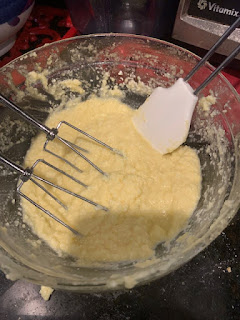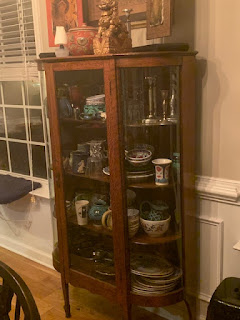I am a casual participant in the Great Meridian Bake Along. I don't have time to do every challenge, but this week's challenge was "A Period Bake in a Period Tablescape" and I have one day left of vacation. Since I collect (hoard?) reproductions of 16th century Italian tableware and linens and have a shelf of historical cookbooks, everything seemed serendipitous.
My recipe was marzipanned tourte (VI 120) from Scappi's Opera1 using a loose web redaction2 I've had forever. The recipe is from Book VI of the Opera: Dishes for the Sick and Convalescent. I admit to being a bit lazy on doing my own redactions -the fun for me is in the cooking and eating of historical recipes rather than puzzling out the redaction.
The dough mentioned in VI 120 was "a sheet of pastry as above"1. VI 118 is the recipe that actually has the dough: "...made of fine flour, egg yolks, butter, salt, sugar, and rosewater." I used Stirler's redaction for the amounts of each ingredient and the dough came together easily. My only change was that I had a bottle of rose-almond water already open so I used that rather than pure rosewater. Since the filling included almond paste, I thought it was a reasonable substitute.
The almond paste in Scully's translation is: "get a pound of shelled almonds and grind them thoroughly in a mortar. Have a pound of melted sugar boiling in a casserole pot and put the almonds in it until they become a paste. Put it back in the mortar and grind it up again.
Stirler's almond paste calls for 2 ounces ground almonds, 3 ounces sugar, 1 egg and one ounce of butter. I used almond flour since it is essentially ground almonds. The end product was loose and despite extensive beating, lumpy. But since it was going to be filling, I didn't worry about the lumps (too much).
The next part is where Scully and Stirler really diverge. Per Scully: "when it (the almond paste) has cooled, add in six egg whites and a beaker of milk made from melon seeds." The "milk made from melon seeds" threw me and I didn't want to get derailed researching it, so I ran with Stiler's redaction for this part. In retrospect, I suspect almond milk might have worked. I'm pondering marzipan for Baroness Isabetta's Vigil table next month, so I may go back and revisit Scully's translation soon.
Stirler mixes the almond paste with: "1/2 c pastry cream or 1 vanilla pudding snack cup or 4 oz of cream cheese or 1/2 c ricotta cheese."2 I shuddered at the thought of using a vanilla pudding cup and went with ricotta cheese.
Stirler and Scully also diverged on what to do with the filling. Scully says put it a torte pan lined with a sheet of dough. Stirler says to cut the dough into 24 rounds. Since it was more in line with Scully, who translated from the original Italian, my plan was to make a single torte. However, since I did not have enough filling for a torte or ingredients to make a second batch of filling, rounds it was going to be! From this point on, I would be following Stirler's redaction.
I baked them at 420 degrees for 13 minutes, then brushed them with an egg glaze and put them back in for 5 minutes, as per Stirler. If I make these again, I think I'd keep them in a few minutes less. They weren't burnt, but they were a bit browner than I wanted.
--------------------
Scully, Terence trans. The Opera of Bartolomeo Scappi (1570). Torento: University of Toronto Press, 2011.
Stirler, Gael. "Three Recipes from The Opera of Bartolomeo Scappi (1570)" https://stores.renstore.com/food-and-drink/renaissance-treats#.Vy1Msr5Ggqg Accessed 3 January 2022.
Liedtke, Walter. "Still Life Painting in Northern Europe: 1600-1800" Metropolitan Museum of Art Heilbrunn Timeline of Art History. https://www.metmuseum.org/toah/hd/nstl/hd_nstl.htm Accessed 3 January 2022.
--- . "The Origins of Still Life in Italy" https://galleriaborghese.beniculturali.it/en/exhibition/lorigine-della-natura-morta-in-italia-caravaggio-e-il-maestro-hartford/# Accessed 3 January 2022.












